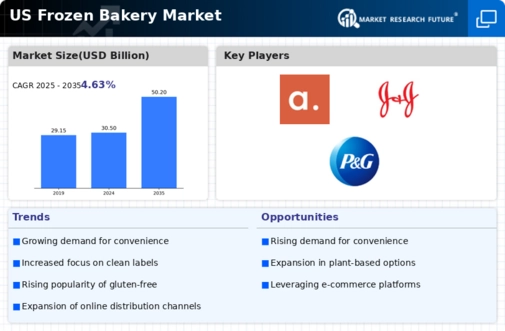Growth of Snacking Trends
The frozen bakery market is witnessing a surge in the popularity of snack-sized products. As consumers increasingly seek convenient and portable food options, frozen snacks such as mini pastries, bite-sized breads, and frozen desserts are gaining traction. This trend is particularly pronounced among younger demographics, who favor quick and easy meal solutions. In 2025, snack-sized products are projected to account for approximately 15% of total sales in the frozen bakery market. This shift towards snacking reflects broader changes in consumer eating habits, suggesting that manufacturers may need to adapt their product lines to meet this evolving demand.
Expansion of Foodservice Channels
The frozen bakery market is benefiting from the expansion of foodservice channels, including restaurants, cafes, and catering services. As these establishments seek to streamline operations and reduce waste, they increasingly turn to frozen bakery products for their convenience and consistency. In 2025, foodservice sales are expected to represent around 40% of the total revenue in the frozen bakery market. This trend suggests that foodservice operators are recognizing the value of frozen products in maintaining quality while managing costs. The ability to offer a diverse range of baked goods without the need for extensive kitchen facilities further enhances the appeal of frozen bakery items in this sector.
Innovations in Freezing Technology
Advancements in freezing technology are playing a crucial role in the evolution of the frozen bakery market. New methods, such as cryogenic freezing and blast freezing, are enhancing the quality and shelf life of frozen products. These innovations allow for better preservation of flavor, texture, and nutritional value, which is increasingly important to health-conscious consumers. As a result, manufacturers are able to produce a wider variety of frozen bakery items that meet consumer expectations for freshness and quality. In 2025, it is anticipated that products utilizing advanced freezing techniques will constitute approximately 30% of the offerings in the frozen bakery market.
Rising Demand for Artisan Products
The frozen bakery market is experiencing a notable increase in demand for artisan-style products. Consumers are increasingly seeking high-quality, handcrafted items that offer unique flavors and textures. This trend is driven by a growing appreciation for gourmet food experiences, which has led to a surge in the production of frozen artisan breads, pastries, and desserts. In 2025, the market for artisan frozen bakery products is projected to account for approximately 25% of total sales in the frozen bakery market. This shift towards premium offerings indicates a potential for higher profit margins, as consumers are willing to pay a premium for perceived quality and authenticity.
Increased Focus on Sustainable Practices
Sustainability is becoming a pivotal concern within the frozen bakery market. Consumers are increasingly favoring brands that demonstrate a commitment to environmentally friendly practices, such as using organic ingredients and sustainable packaging. This shift is prompting manufacturers to adopt greener production methods and supply chain practices. In 2025, it is estimated that around 20% of consumers will prioritize sustainability when purchasing frozen bakery products. This trend indicates a potential for growth in the market segment that emphasizes eco-friendly offerings, as brands that align with these values may capture a larger share of the consumer base.














Leave a Comment